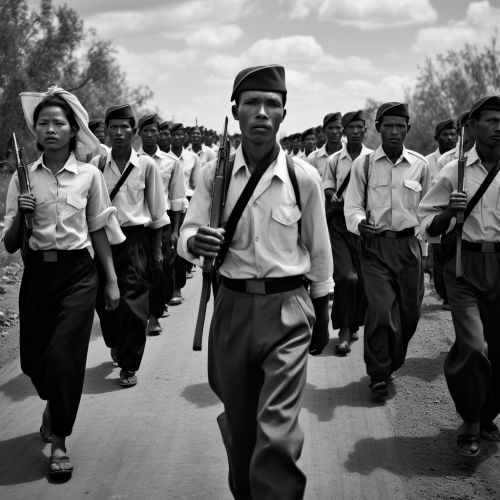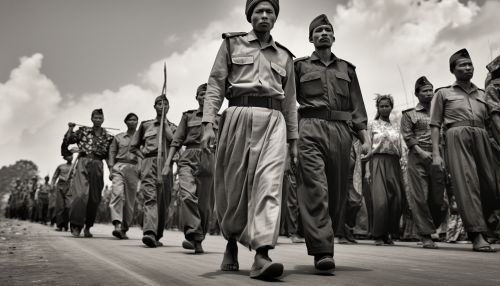Khmer Rouge rule of Cambodia
Background
The Khmer Rouge was a radical communist regime that ruled Cambodia from 1975 to 1979. The regime, led by Pol Pot, sought to transform Cambodia into a rural, classless society in which there were no wealthy people, no poor people, and no exploitation. To accomplish this, they abolished money, free markets, normal schooling, private property, foreign clothing styles, religious practices, and traditional Khmer culture. Public schools, pagodas, mosques, churches, universities, shops and government buildings were shut or turned into prisons, stables, reeducation camps and granaries. There was no public or private transportation, no private property, and no non-revolutionary entertainment. Leisure activities were severely restricted. People throughout the country, including the urban educated, were relocated to the countryside to work in collective farms and forced labor projects. The purpose of this policy was to turn urban dwellers into rural ones. The Khmer Rouge believed that parents were tainted with capitalism and therefore, they separated children from their parents to indoctrinate them in communism.


Rise to Power
The Khmer Rouge came to power following a civil war that lasted from 1970 to 1975. The war began when the ruling monarch, Norodom Sihanouk, was overthrown in a military coup led by his own prime minister, Lon Nol. Sihanouk, who had been neutral in the ongoing Vietnam War, formed an alliance with the Khmer Rouge and urged his followers to support them. This led to a surge in the Khmer Rouge's popularity and they were able to seize control of the country after a brutal five-year war.
Policies and Actions
Once in power, the Khmer Rouge implemented one of the most radical and brutal restructurings of a society ever attempted. Its goal was to transform Cambodia into a peasant-dominated agrarian cooperative. Currency was abolished and the banking system was dismantled. All political and civil rights were repressed. Schools and hospitals were closed. Religion was banned, all Christian, Muslim, and Buddhist places of worship were shut and their leaders were either forced to convert to atheism or were executed. The regime particularly targeted intellectuals, city residents, minority people like the Cham Muslims and the Vietnamese, civil servants and officials of the previous regime, soldiers, and the police of the old regime.
Democide and Famine
The Khmer Rouge's policies led to massive death tolls through executions, work exhaustion, illness, and starvation. People were often forced to work for 12 hours non-stop, without adequate rest or food. These mass killings, coupled with malnutrition, strenuous physical labor, and poor medical care, killed approximately 1.7 million people (around a quarter of the population). This period gave rise to the term "Killing Fields". Also, the Khmer Rouge's policy of forcing evacuated urban dwellers to work as peasants resulted in massive deaths through execution, starvation, disease, and overwork.
Fall of the Khmer Rouge
The Khmer Rouge regime was removed from power in 1979 when Vietnam invaded Cambodia and quickly destroyed most of the Khmer Rouge's forces. The Khmer Rouge then retreated to Thailand whose government saw them as a buffer force against the Vietnamese. The Khmer Rouge continued to fight the Vietnamese and the new People's Republic of Kampuchea government during the Cambodian–Vietnamese War which ended in 1989. The Khmer Rouge survived into the 1990s as a resistance force operating in the western jungles along the border with Thailand. In 1996, following a peace agreement, their leader Pol Pot was arrested and sentenced to house arrest by his own followers.
Aftermath and Legacy
The Khmer Rouge left a deep and lasting impact on Cambodia. The regime's policies led to widespread death and suffering. The population was so devastated and dislocated that recovery has been slow and painful. The societal disruption and trauma caused by the Khmer Rouge's rule have made it difficult for Cambodia to fully recover even today.
